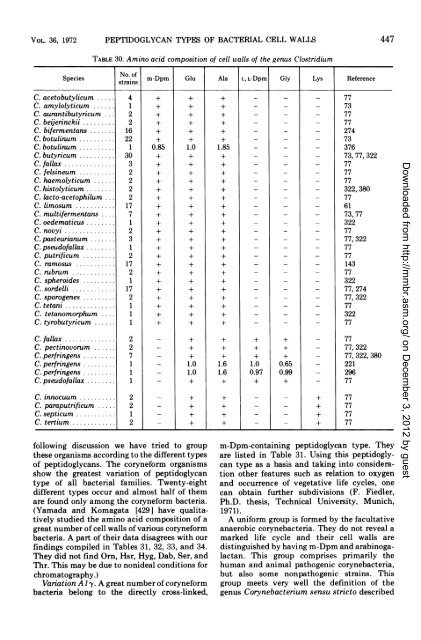Peptidoglycan .Types of Bacterial Cell Walls and their Taxonomic ...
Peptidoglycan .Types of Bacterial Cell Walls and their Taxonomic ...
Peptidoglycan .Types of Bacterial Cell Walls and their Taxonomic ...
Create successful ePaper yourself
Turn your PDF publications into a flip-book with our unique Google optimized e-Paper software.
VOL. 36, 1972 PEPTIDOGLYCAN TYPES OF BACTERIAL CELL WALLS<br />
447<br />
TABLE 30. Amino acid composition <strong>of</strong> cell walls <strong>of</strong> the genus Clostridium<br />
Species strains m-Dpm Glu Ala L-Dpm Gly Lys<br />
C. acetobutylicum .....<br />
C. amylolyticum ......<br />
C. aurantibutyricum ...<br />
C. beijerinckii .........<br />
C. bifermentans .......<br />
C. botulinum ..........<br />
C. botulinum ..........<br />
C. butyricum ..........<br />
C. fallax ..............<br />
C. felsineum ..........<br />
C. haemolyticum ......<br />
C. histolyticum ........<br />
C. kacto-acetophilum ...<br />
C. limosum ...........<br />
C. multifermentans ....<br />
C. oedematicus ........<br />
C. novyi ..............<br />
C. pasteurianum .......<br />
C. pseud<strong>of</strong>allax ........<br />
C. putrificum .........<br />
C. ramosus ...........<br />
C. rubrum ............<br />
C. spheroides .........<br />
C. sordelli ............<br />
C. sporogenes .........<br />
C. tetani ..............<br />
C. tetanomorphum ....<br />
C. tyrobutyricum ......<br />
C. fallax ..............<br />
C. pectinovorum ......<br />
C. perfringens .........<br />
C. perfringens .........<br />
C. perfringens .........<br />
C. pseud<strong>of</strong>allax ........<br />
C. innocuum ..........<br />
C. paraputrificum .....<br />
C. septicum ...........<br />
C. tertium ............<br />
4 122<br />
16<br />
22 1<br />
following discussion we have tried to group<br />
these organisms according to the different types<br />
<strong>of</strong> peptidoglycans. The coryneform organisms<br />
show the greatest variation <strong>of</strong> peptidoglycan<br />
type <strong>of</strong> all bacterial families. Twenty-eight<br />
different types occur <strong>and</strong> almost half <strong>of</strong> them<br />
are found only among the coryneform bacteria.<br />
(Yamada <strong>and</strong> Komagata [4291 have qualitatively<br />
studied the amino acid composition <strong>of</strong> a<br />
great number <strong>of</strong> cell walls <strong>of</strong> various coryneform<br />
bacteria. A part <strong>of</strong> <strong>their</strong> data disagrees with our<br />
findings compiled in Tables 31, 32, 33, <strong>and</strong> 34.<br />
They did not find Orn, Hsr, Hyg, Dab, Ser, <strong>and</strong><br />
Thr. This may be due to nonideal conditions for<br />
chromatography.)<br />
Variation A 1y. A great number <strong>of</strong> coryneform<br />
bacteria belong to the directly cross-linked,<br />
30 32222<br />
17 712312<br />
1721<br />
17 21<br />
1<br />
1<br />
2<br />
2<br />
7 111<br />
2 21<br />
2<br />
0.8<br />
+<br />
+<br />
+<br />
+<br />
+<br />
+<br />
+.<br />
+<br />
+<br />
+<br />
+<br />
+<br />
+<br />
+<br />
+<br />
+.<br />
+.<br />
1.8<br />
+<br />
+<br />
+<br />
+<br />
1.85<br />
+.<br />
1.0<br />
0.97<br />
+<br />
0.65<br />
0.99<br />
+<br />
m-Dpm-containing<br />
are listed in Table<br />
77<br />
73<br />
77<br />
77<br />
_ 274<br />
73<br />
_ 376<br />
73, 77, 322<br />
77<br />
77<br />
77<br />
322, 380<br />
77<br />
61<br />
73, 77<br />
322<br />
77<br />
77, 322<br />
77<br />
_ 77<br />
143<br />
77<br />
_ 322<br />
77, 274<br />
_ 77, 322<br />
_ 77<br />
_ 322<br />
_ 77<br />
77<br />
77, 322<br />
77,322,380<br />
221<br />
296<br />
_ 77<br />
+ 77<br />
77<br />
77<br />
77<br />
peptidoglycan type. They<br />
31. Using this peptidogly-<br />
can type as a basis <strong>and</strong> taking into consideration<br />
other features such as relation to oxygen<br />
<strong>and</strong> occurrence <strong>of</strong> vegetative life cycles, one<br />
can obtain further subdivisions (F. Fiedler,<br />
Ph.D. thesis, Technical University, Munich,<br />
1971).<br />
A uniform group is formed by the facultative<br />
anaerobic corynebacteria. They do not reveal a<br />
marked life cycle <strong>and</strong> <strong>their</strong> cell walls are<br />
distinguished by having m-Dpm <strong>and</strong> arabinogalactan.<br />
This group comprises primarily the<br />
human <strong>and</strong> animal pathogenic corynebacteria,<br />
but also some nonpathogenic strains. This<br />
group meets very well the definition <strong>of</strong> the<br />
genus Corynebacterium sensu stricto described<br />
Downloaded from<br />
http://mmbr.asm.org/<br />
on December 3, 2012 by guest




